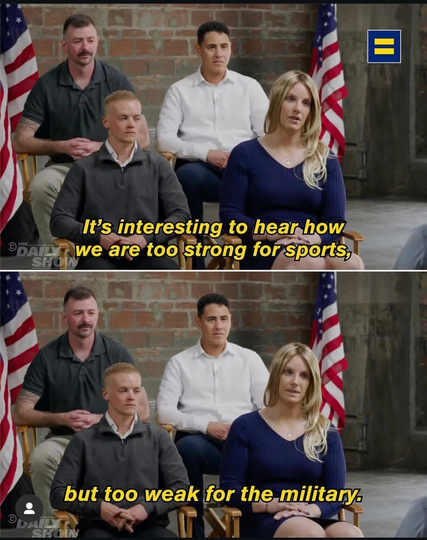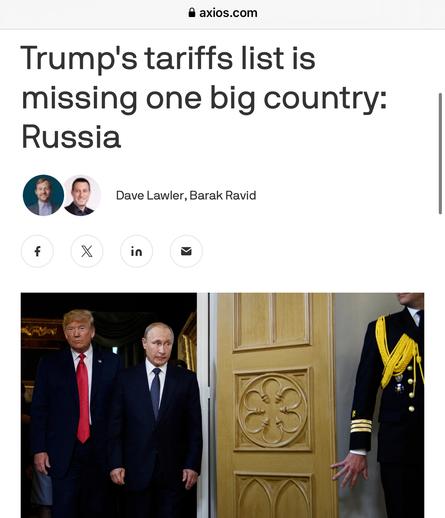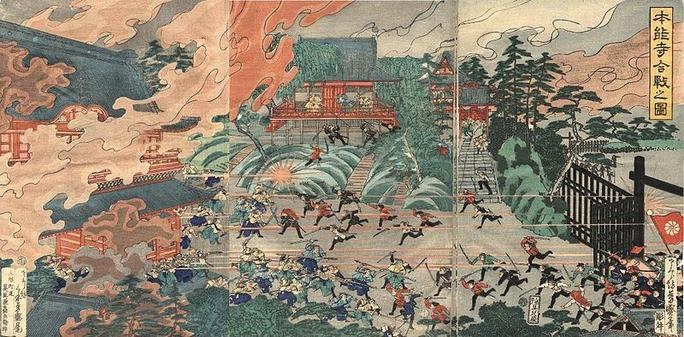"The reality is that there is no rational basis for this spate of actions. These guys just can’t help themselves. The urge to dominate people and institutions and make them conform to Trump’s will is just too strong for them to resist," writes Benjamin Wittes in the Situation. https://www.lawfaremedia.org/article/the-situation--they-just-can-t-help-themselves
up up down down left right left right B A decent person you fuckers
Met the meowiest cat on our walk this morning.
I’m going to say this slowly.
If Andrew Tate & his ilk were right about ANYTHING they’d have no audience.
Guys would listen briefly, apply advice, & be WAY too busy with their new gfs, side-pieces, & high income hustles to bother tuning in.
It’s the Tinder principle: if you’re happy, they lose a customer.
Their business model is your unending misery.
Carney’s Checkmate: How Canada's Quiet Bond Play Forced Trump to Drop Tariffs
https://deanblundell.substack.com/p/carneys-checkmate-how-canadas-quiet
“This was the determining factor in Trump’s surrender. Not the public spats, not the retaliatory tariffs Canada slapped on U.S. autos (though those stung). It was the quiet, coordinated threat of a Treasury bond unwind that bent Trump’s knee.”
Aside: Why are we calling northern countries like Canada, much of Europe, Japan.. the “free world”?
So weird how this keeps happening. www.axios.com/2025/04/02/t...
There is something very wrong in this country when six young people meeting to discuss politics in a Quaker Meeting House are arrested by the police after a mass (twenty officers) invasion of the building (armed with tasers).
The freedom to protest, or even the freedom to meet in a room to discuss current affairs, are central to a democracy... if this freedom is now compromised (further), as it seems to be, we are in a very bad place!
h/t @Thebratdragon
"There's no feminism in Japan!!" claim dudes on their fourth anime waifu body pillow. That's not true. It's so not true, in fact, that we wrote a three-part series detailing extremely how not true it is. Learn more about feminism in Japan from Meiji to today.
https://unseen-japan.com/feminist-movement-in-japan-meiji-wwii/
Filipino-American Maria Ressa won the Nobel Peace Prize for fighting against disinformation. I hope you all will listen to her.
The Philippines was a colony of the United States. We were the victims of this information war. Now it's the Americans. The Philippines was your "petridish". The Philippinization of America is happening before your eyes.
"Tesla protesters are planning their “biggest day of action” yet, aiming for 500 demonstrations at Tesla showrooms across the world on March 29th..."
https://www.theverge.com/news/633091/tesla-takedown-protesters-planning-biggest-day-of-action
This is disgusting
https://taskandpurpose.com/news/arlington-cemetery-scrubs-website-dei/
@Arkenston this looks like Ella Purnell
Okay, so this is a ways off, but what follows is an attempt to briefly outline for your enjoyment and edification what a hypothetical book by me on the Boshin War would look like.
First, it would follow Ishii Takashi's view that this was not one war, but three in one.
One side, the nascent Kyoto government, was consistent throughout. The other was not.
So we have the war from Kyoto to Edo against the former Shogunate, the war in Tohoku against the Northern Alliance, and the war in Ezo against the so-called Republic
Ōyama Kashiwa, whom I mentioned earlier, calls it "the Boshin campaign," which I think also has some utility.
I would also very sharply distinguish between the combatants fighting the Kyoto government. the Northern Alliance was not "pro-shogun," though it was allied with the former Shogunate's army
this is because of a thousand years of precedent of regional semi-autonomy. I wrote my dissertation on this. No, it doesn't matter what the tourist website you encountered told you, they're wrong.
You need to understand the Northern Fujiwara to understand the Tohoku alliance.
a longue duree perspective will likewise be necessary, because the outcome of this war, especially in the Tohoku region, was decided decades in advance, in part because of famine and depopulation.
they could never have won, not for lack of technology but because of the Tenpo Famine.
It will be brutal to write about the war, as writing about war necessarily is, because the so-called imperial army chose to exercise such brutality. They made it illegal for Aizu domain to bury its own dead, and thus so profoundly polluted the land that some Aizu survivors became Christian.
We will also need to appreciate the role of the foreign powers beyond what is normally spoken of in what English scholarship exists. the Northern Alliance petitioned the US for aid. the British were actively running guns to Satsuma. The French military mission was embedded in the Shogunate Army.
Women in combat, likewise, must be given attention, and no, I'm not simply speaking of Nakano Takeko.
Yamamoto Yae, for one, is right the hell there.
We will have to dismantle myths about the war, too, like the claim that the Tohoku alliance fought to restore the Shogun and hated guns.
But especially we will need to underline that Enomoto's government in Hakodate was. not. a. republic.
We will need to also underscore how this was significantly the samurai caste fighting itself, because there are petitions written by townsmen and farmers begging both sides to knock it the fuck off, at least long enough to bring the harvest in.
Finally, we will need to understand that the Boshin War, in a sense, didn't really end. Its survivors on all sides got tied up in different movements over the course of the Meiji era-- some were Saigo's men in the Seinan War, others were Itagaki's allies in the Freedom and Popular Rights Movement, and...
….until the 1920s, saying anything against the official imperialist line was in some cases punishable by ostracism and prison.
So, who broke through that silence? How did they do it?
We will have to give them their due. #JapaneseHistory #history #samurai
@PusherRobot How do you help people in space?
Looking at how #LLM are promoted by their fans, I've come to the conclusion:
Pretty much everyone from a #STEM background - myself definitely included! - owes the #Humanities a huge apology.
I mean, I get it. When I was a young student of physics, it was easy for me to sneer at philosophy students and whatnot. After all, _we_ dealt with hard, measurable facts, while _those_ people dealt with some weird thought constructs that had no relevancy to the real world - right?
But this is the end result - #TechBro culture and a vast portion of our entire economy using digital bullshit generators instead of critical thinking, and using this to lead us into a fascist future where either Truth or Facts have become meaningless.
Mea culpa.
We hear a lot about Stoicism these days, but could Epicureanism be a good alternative to coping in the modern world?
https://fivebooks.com/best-books/epicureans-james-warren/



